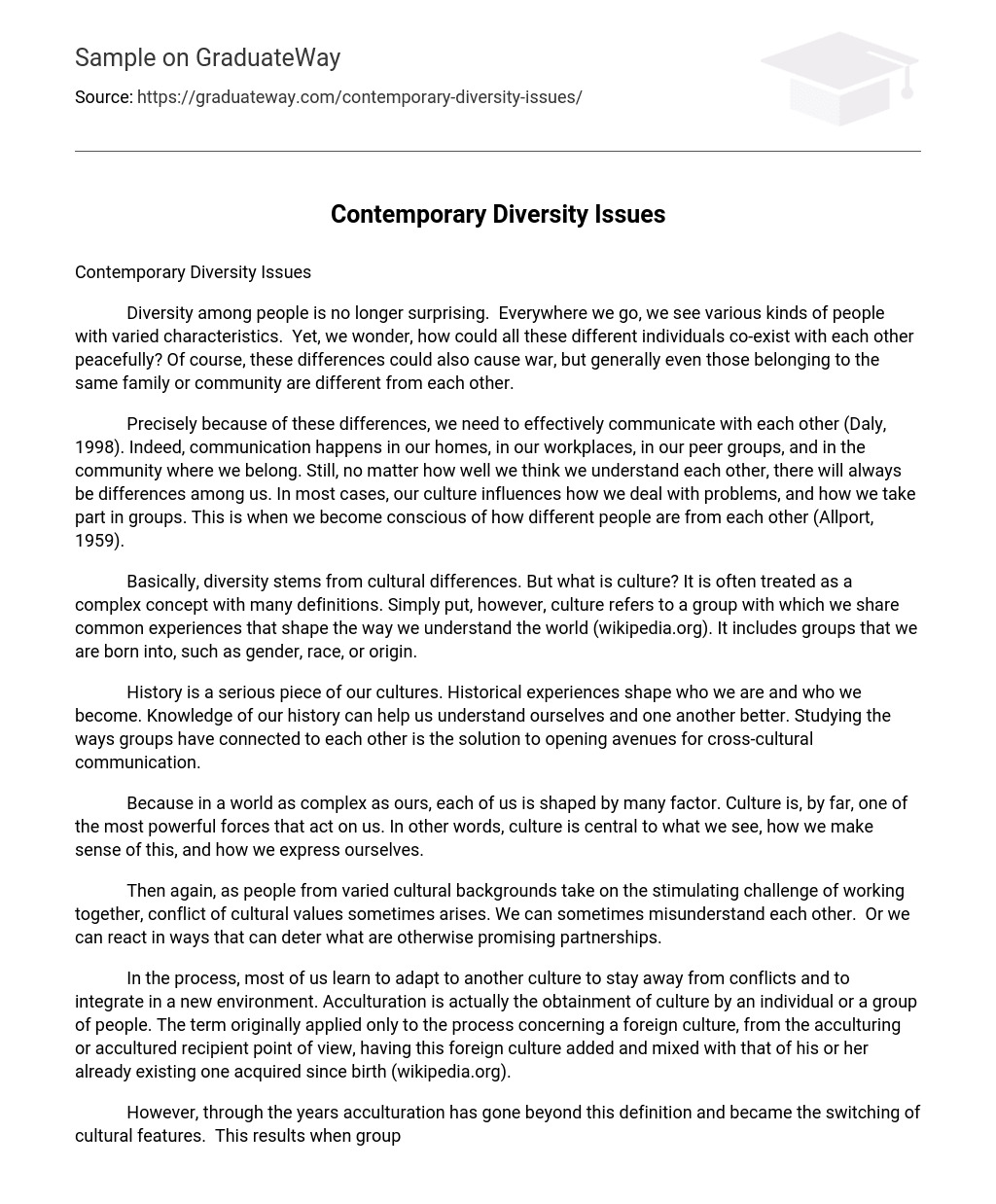Diversity among people is no longer surprising. Everywhere we go, we see various kinds of people with varied characteristics. Yet, we wonder, how could all these different individuals co-exist with each other peacefully? Of course, these differences could also cause war, but generally even those belonging to the same family or community are different from each other.
Precisely because of these differences, we need to effectively communicate with each other (Daly, 1998). Indeed, communication happens in our homes, in our workplaces, in our peer groups, and in the community where we belong. Still, no matter how well we think we understand each other, there will always be differences among us. In most cases, our culture influences how we deal with problems, and how we take part in groups. This is when we become conscious of how different people are from each other (Allport, 1959).
Basically, diversity stems from cultural differences. But what is culture? It is often treated as a complex concept with many definitions. Simply put, however, culture refers to a group with which we share common experiences that shape the way we understand the world (wikipedia.org). It includes groups that we are born into, such as gender, race, or origin.
History is a serious piece of our cultures. Historical experiences shape who we are and who we become. Knowledge of our history can help us understand ourselves and one another better. Studying the ways groups have connected to each other is the solution to opening avenues for cross-cultural communication.
Because in a world as complex as ours, each of us is shaped by many factor. Culture is, by far, one of the most powerful forces that act on us. In other words, culture is central to what we see, how we make sense of this, and how we express ourselves.
Then again, as people from varied cultural backgrounds take on the stimulating challenge of working together, conflict of cultural values sometimes arises. We can sometimes misunderstand each other. Or we can react in ways that can deter what are otherwise promising partnerships.
In the process, most of us learn to adapt to another culture to stay away from conflicts and to integrate in a new environment. Acculturation is actually the obtainment of culture by an individual or a group of people. The term originally applied only to the process concerning a foreign culture, from the acculturing or accultured recipient point of view, having this foreign culture added and mixed with that of his or her already existing one acquired since birth (wikipedia.org).
However, through the years acculturation has gone beyond this definition and became the switching of cultural features. This results when groups come into incessant actual contact. Groups of the primary cultural patterns may be changed a bit, but they remain distinctive overall. Acculturation then involves different levels of demolition, endurance, supremacy, struggle, adjustment, and modification of native cultures following inter-ethnic acquaintance.
Of course, in societies where there’s a dominant and an ethnic culture, conflicts arising from diversity is all the more magnified. Ordinarily, discrimination happens in this case. When one belongs to the dominant culture, he is most likely to receive all the benefits accorded to citizens without any problem. On the other hand, if one belongs to an ethnic culture, there is almost always a limit to his movements. Although he is likewise entitled to all the benefits of a citizen, he is most likely to encounter many difficulties before he can receive them.
One prime example of this is the African-Americans who, though they are legally U.S. citizens, still suffer from racial discrimination (Allport). In schools, black children are sometimes teased for their skin color. In supermarkets, black customers are often treated unfairly. Of course, this kind of problem has already been legally addressed but the fact remains that racial discrimination is still very much prevalent in many countries.
This is the reason why it is very vital to understand ourselves and our own cultural frames of reference. An appreciation of communication patterns of a society can also support the dispensation of what it means to be different in ways that are courteous of others.
We can also learn to work in collaboration across cultural lines as individuals living in a multi-cultural society. Indeed, appreciating cultural differences does not have to cause estrangement among individuals. In fact, growing more conscious of our cultural disparities can help us get along with each other more successfully.
In the end, learning how people communicate can enrich our lives. The various communication styles of people reflect deeper world views that are the underpinning of their culture (Adler, 1986). Figuring out these deeper philosophies gives us a broader picture of what the world has to offer.
Lastly, if we are open to learning about people from other cultures, we become less lonesome. Prejudice and stereotypes separate us from whole groups of people who, otherwise, could be partners in working for change (Adler). Talking with people who may be different from us gives us hope. It strengthens us to take on the challenge of improving the world.
References:
Adler, Nancy J. (1986). Cultural Synergy: Managing the Impact of Cultural Diversity. 1986 Annual: Developing Human Resources. San Diego: University Associates.
Allport, Gordon W. (1959).The Nature of Prejudice. Reading, Mass.: Addison-Wesley.
Daly, Alfreda, ed., (1998). Workplace Diversity: Issues and Perspectives, National Association of Social Workers (NASW), Washington, D.C.
www.wikipedia.org





